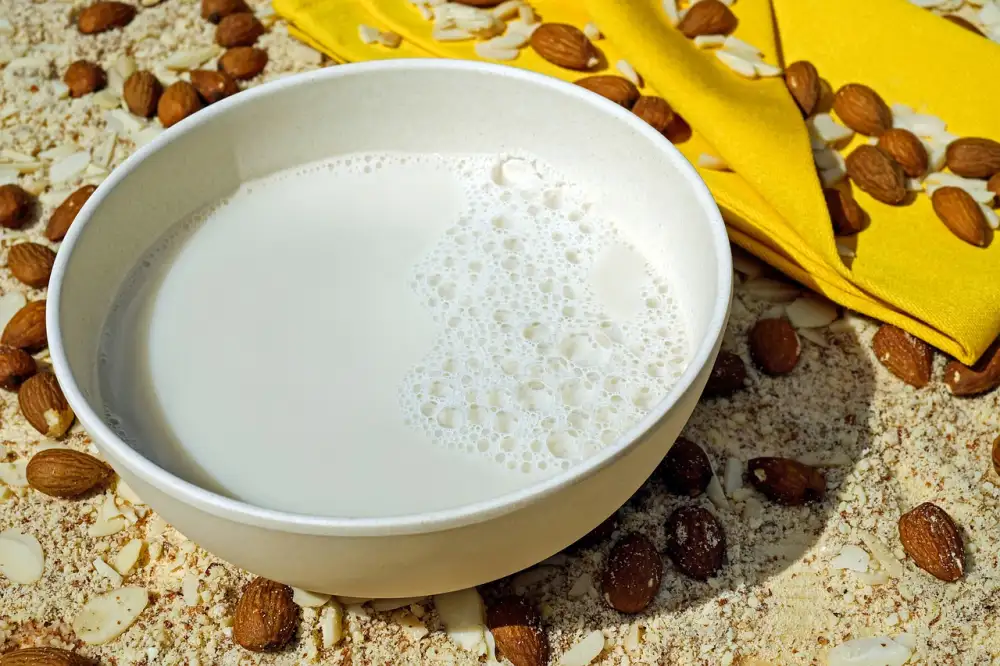Almond Milk Shelf Life: How Long Does Almond Milk Last and Signs of Spoilage

- Overview of almond milk as a popular dairy alternative
- Importance of understanding its shelf life and spoilage signs
- Shelf Life of Almond Milk
- Explanation of the typical shelf life of almond milk
- Factors that can affect its longevity, such as packaging and storage conditions
- Signs of Spoilage
- Description of visual indicators of spoiled almond milk, such as curdling or separation
- Explanation of off-smells or off-flavors that may develop in spoiled almond milk
- Proper Storage Tips
- Guidance on how to store almond milk to maximize its freshness and extend its shelf life
- Suggestions for refrigeration and avoiding exposure to heat or sunlight
- Safety Concerns
- Brief discussion on potential health risks associated with consuming spoiled almond milk
- Importance of checking for signs of spoilage before consuming
- Recap of key points regarding the shelf life and spoilage signs of almond milk
- Encouragement to prioritize food safety and freshness when consuming almond milk
Almond milk has become a popular dairy alternative for many people due to its creamy texture and nutty flavor. Whether you use it in your morning coffee, smoothies, or baking recipes, understanding the shelf life of almond milk is crucial. Knowing how long it lasts and recognizing signs of spoilage can help ensure that you are consuming fresh and safe almond milk. In this article, we will explore the typical shelf life of almond milk, factors that can affect its longevity, signs of spoilage to watch out for, proper storage tips, safety concerns, and the importance of prioritizing food safety when consuming almond milk.
Overview of almond milk as a popular dairy alternative
Almond milk has gained popularity as a dairy alternative due to its creamy texture and nutty flavor. Made from ground almonds and water, it is a suitable option for those who are lactose intolerant or follow a vegan diet. Almond milk is also rich in vitamins and minerals, making it a nutritious choice. Understanding the shelf life of almond milk is crucial to ensure its freshness and quality. Let's explore how long almond milk lasts and the signs of spoilage to look out for.
Importance of understanding its shelf life and spoilage signs
Understanding the shelf life and spoilage signs of almond milk is crucial for ensuring food safety and enjoying its freshness. As a popular dairy alternative, almond milk has gained popularity among individuals with lactose intolerance or those following a plant-based diet. However, like any perishable product, almond milk can spoil over time, leading to potential health risks if consumed past its expiration date. By being aware of its shelf life and recognizing signs of spoilage, consumers can make informed decisions about consuming almond milk and avoid any potential health hazards.
Shelf Life of Almond Milk
The typical shelf life of almond milk is around 7 to 10 days when stored properly. However, this can vary depending on factors such as packaging and storage conditions. Almond milk that is sold in aseptic cartons tends to have a longer shelf life compared to those sold in refrigerated containers. Additionally, exposure to heat or sunlight can accelerate the spoilage process. It is important to check the expiration date and follow proper storage guidelines to ensure the freshness of your almond milk.
Explanation of the typical shelf life of almond milk
Almond milk typically has a shelf life of about 7-10 days when stored properly. This can vary depending on factors such as the brand, packaging, and storage conditions. Some brands may have a longer shelf life of up to a month. It is important to check the expiration date on the package and consume it before that date for optimal freshness. Additionally, homemade almond milk may have a shorter shelf life and should be consumed within 3-4 days.
Factors that can affect its longevity, such as packaging and storage conditions
The longevity of almond milk can be influenced by various factors, including its packaging and storage conditions. Almond milk is typically sold in cartons or bottles, which are designed to protect it from light and air exposure. These containers help to maintain the freshness of the milk for a longer period. Additionally, the storage conditions play a crucial role in preserving almond milk. It is important to store it in a cool and dry place, away from direct sunlight and heat sources. Properly sealed containers and refrigeration can significantly extend the shelf life of almond milk.
Signs of Spoilage
Spoiled almond milk can exhibit visual indicators such as curdling or separation. If you notice chunks or clumps in the milk, it is a clear sign that it has gone bad. Additionally, the color may change to a yellowish or grayish tone.
Another key indicator of spoilage is off-smells or off-flavors. If your almond milk smells sour, rancid, or has an unpleasant odor, it's best to discard it. Similarly, if the taste is off and doesn't resemble fresh almond milk, it's likely spoiled.
Remember to always check for these signs before consuming almond milk to ensure its freshness and quality.
Description of visual indicators of spoiled almond milk, such as curdling or separation
When almond milk spoils, there are visual indicators that can help you determine its freshness. One common sign is curdling or separation of the liquid. If you notice clumps or chunks floating in the almond milk, it is a clear indication that it has gone bad. The texture may become thicker and grainy as well. These changes in consistency are a result of bacterial growth and should not be consumed.
Explanation of off-smells or off-flavors that may develop in spoiled almond milk
Spoiled almond milk may develop off-smells or off-flavors that are distinct and unpleasant. These can include a sour or rancid odor, similar to spoiled dairy products. The taste of spoiled almond milk may also be bitter or acidic. If you notice any strange or off-putting smells or flavors when opening or tasting your almond milk, it is a clear indication that it has gone bad and should not be consumed.
Proper Storage Tips
To maximize the freshness and extend the shelf life of almond milk, it is important to store it correctly. First, always check the label for any specific storage instructions provided by the manufacturer. In general, almond milk should be refrigerated at all times, even before opening. Keep it in the coldest part of your refrigerator, away from other strong-smelling foods.
Avoid exposing almond milk to heat or sunlight, as these can accelerate spoilage. It's best to keep it in its original packaging or transfer it to an airtight container if necessary. Make sure the container is clean and dry before pouring in the almond milk.
Remember to seal the container tightly after each use to prevent air and bacteria from entering. Additionally, avoid using dirty utensils or hands when handling almond milk, as this can introduce contaminants.
By following these proper storage tips, you can help maintain the freshness and quality of your almond milk for a longer period of time.
Guidance on how to store almond milk to maximize its freshness and extend its shelf life
To maximize the freshness and extend the shelf life of almond milk, it is important to store it properly. First, always check the expiration date on the packaging before purchasing. Once opened, reseal tightly and keep refrigerated at all times. Avoid exposing almond milk to heat or sunlight, as this can accelerate spoilage. Additionally, try to consume it within 7-10 days after opening for best quality. Following these storage tips will help ensure that your almond milk stays fresh and safe to consume for a longer period of time.
Suggestions for refrigeration and avoiding exposure to heat or sunlight
To maximize the freshness and extend the shelf life of almond milk, it is important to store it properly. Refrigeration is key in keeping almond milk fresh for longer periods. Make sure to place the almond milk in the coldest part of the refrigerator, ideally at a temperature below 40°F (4°C).
Additionally, it is crucial to avoid exposing almond milk to heat or sunlight as they can accelerate spoilage. Heat can cause bacteria growth while sunlight can degrade the quality of the milk. Store almond milk in a cool and dark area, away from direct sunlight or any sources of heat.
By following these storage suggestions, you can ensure that your almond milk remains fresh and safe to consume for an extended period.
Safety Concerns
While almond milk is generally considered safe to consume, it is important to be aware of potential health risks associated with consuming spoiled almond milk. When almond milk spoils, harmful bacteria can multiply, leading to foodborne illnesses such as diarrhea, vomiting, and abdominal pain.
To ensure your safety, always check for signs of spoilage before consuming almond milk. If you notice any unusual smells, flavors, or changes in texture such as curdling or separation, it is best to discard the milk. Additionally, if the almond milk has been stored improperly or past its expiration date, it is safer to err on the side of caution and avoid consumption.
Prioritizing food safety and freshness when consuming almond milk will help prevent any potential health issues and ensure a pleasant drinking experience.
Brief discussion on potential health risks associated with consuming spoiled almond milk
Consuming spoiled almond milk can pose potential health risks. As it is a perishable product, consuming spoiled almond milk may lead to foodborne illnesses such as stomach cramps, diarrhea, and vomiting. Bacteria such as E. coli or Salmonella can grow in spoiled almond milk, causing these symptoms. It is crucial to check for signs of spoilage before consuming almond milk to ensure your safety and well-being.
Importance of checking for signs of spoilage before consuming
It is crucial to check for signs of spoilage before consuming almond milk. Consuming spoiled almond milk can lead to foodborne illnesses and discomfort. By being vigilant and checking for visual indicators such as curdling or separation, as well as off-smells or off-flavors, you can ensure that the almond milk is safe to consume. Prioritizing food safety and freshness will help protect your health and enhance your overall dining experience.
In conclusion, it is important to be aware of the shelf life and signs of spoilage when consuming almond milk. Understanding how long almond milk lasts and recognizing indicators of spoilage can help ensure food safety and freshness. Remember to check for visual changes, off-smells, or off-flavors before consuming almond milk. Proper storage techniques, such as refrigeration and avoiding exposure to heat or sunlight, can also extend its shelf life. Prioritizing food safety will guarantee a delightful and healthy almond milk experience.
Recap of key points regarding the shelf life and spoilage signs of almond milk
In conclusion, it is important to be aware of the shelf life and spoilage signs of almond milk. Typically, almond milk has a shelf life of about 7-10 days after opening, but this can vary depending on factors such as packaging and storage conditions. Signs of spoilage include curdling or separation, as well as off-smells or off-flavors. To maximize freshness and extend shelf life, store almond milk in the refrigerator and avoid exposure to heat or sunlight. Always prioritize food safety by checking for signs of spoilage before consuming almond milk.
Encouragement to prioritize food safety and freshness when consuming almond milk
In conclusion, it is crucial to prioritize food safety and freshness when consuming almond milk. By understanding its shelf life and recognizing signs of spoilage, we can ensure that we are consuming a safe and enjoyable product. Always check for visual indicators of spoilage, such as curdling or separation, and be aware of any off-smells or off-flavors. Proper storage techniques, such as refrigeration and avoiding exposure to heat or sunlight, can also help extend the shelf life of almond milk. Remember, your health and well-being should always come first when it comes to consuming any food product.
Published: 10. 12. 2023
Category: Food



